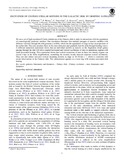Mostrar el registro sencillo del ítem
EXCITATION of COUPLED STELLAR MOTIONS in the GALACTIC DISK by ORBITING SATELLITES
| dc.creator | D'Onghia E. | spa |
| dc.creator | Madau P. | spa |
| dc.creator | Vera-Ciro C. | spa |
| dc.creator | Quillen A. | spa |
| dc.creator | Hernquist L. | spa |
| dc.date.accessioned | 2016-07-27T20:34:30Z | |
| dc.date.available | 2016-07-27T20:34:30Z | |
| dc.date.created | 2016 | |
| dc.identifier.issn | 0004637X | |
| dc.identifier.uri | http://hdl.handle.net/11407/2480 | |
| dc.description.abstract | We use a set of high-resolution N-body simulations of the Galactic disk to study its interactions with the population of cosmologically predicted satellites. One simulation illustrates that multiple passages of massive satellites with different velocities through the disk generate a wobble, which has the appearance of rings in face-on projections of the stellar disk. They also produce flares in the outer disk parts and gradually heat the disk through bending waves. A different numerical experiment shows that an individual satellite as massive as the Sagittarius dwarf galaxy passing through the disk will drive coupled horizontal and vertical oscillations of stars in underdense regions with small associated heating. This experiment shows that vertical excursions of stars in these low-density regions can exceed 1 kpc in the Solar neighborhood, resembling the recently locally detected coherent vertical oscillations. They can also induce non-zero vertical streaming motions as large as 10-20 km s-1, which is consistent with recent observations in the Galactic disk. This phenomenon appears as a local ring with modest associated disk heating. © 2016. The American Astronomical Society. All rights reserved. | eng |
| dc.language.iso | eng | |
| dc.publisher | Institute of Physics Publishing | spa |
| dc.relation.isversionof | https://www.scopus.com/inward/record.uri?eid=2-s2.0-84971669229&partnerID=40&md5=e782484c0954e46f8429e12719d5ebfa | spa |
| dc.source | Scopus | spa |
| dc.title | EXCITATION of COUPLED STELLAR MOTIONS in the GALACTIC DISK by ORBITING SATELLITES | spa |
| dc.type | Article | eng |
| dc.rights.accessrights | info:eu-repo/semantics/restrictedAccess | |
| dc.rights.accessrights | info:eu-repo/semantics/restrictedAccess | |
| dc.contributor.affiliation | D'Onghia, E., Department of Astronomy, University of Wisconsin, 2535 Sterling Hall, 475 N. Charter Street, Madison, WI, United States | spa |
| dc.contributor.affiliation | Madau, P., University of California Santa Cruz, 1156 High Street, Santa Cruz, CA, United States | spa |
| dc.contributor.affiliation | Vera-Ciro, C., Departamento de Ciencias Basicas, Universidad de Medellin, Cra 87 N30-65, Medellin, Colombia | spa |
| dc.contributor.affiliation | Quillen, A., Department of Physics and Astronomy, University of Rochester, Rochester, NY, United States | spa |
| dc.contributor.affiliation | Hernquist, L., Harvard-Smithsonian Center for Astrophysics, 60 Garden Street, MS-51, United States | spa |
| dc.identifier.doi | 10.3847/0004-637X/823/1/4 | |
| dc.abstract | We use a set of high-resolution N-body simulations of the Galactic disk to study its interactions with the population of cosmologically predicted satellites. One simulation illustrates that multiple passages of massive satellites with different velocities through the disk generate a wobble, which has the appearance of rings in face-on projections of the stellar disk. They also produce flares in the outer disk parts and gradually heat the disk through bending waves. A different numerical experiment shows that an individual satellite as massive as the Sagittarius dwarf galaxy passing through the disk will drive coupled horizontal and vertical oscillations of stars in underdense regions with small associated heating. This experiment shows that vertical excursions of stars in these low-density regions can exceed 1 kpc in the Solar neighborhood, resembling the recently locally detected coherent vertical oscillations. They can also induce non-zero vertical streaming motions as large as 10-20 km s-1, which is consistent with recent observations in the Galactic disk. This phenomenon appears as a local ring with modest associated disk heating. © 2016. The American Astronomical Society. All rights reserved. | eng |
| dc.creator.affiliation | Department of Astronomy, University of Wisconsin, 2535 Sterling Hall, 475 N. Charter Street, Madison, WI, United States | spa |
| dc.creator.affiliation | University of California Santa Cruz, 1156 High Street, Santa Cruz, CA, United States | spa |
| dc.creator.affiliation | Departamento de Ciencias Basicas, Universidad de Medellin, Cra 87 N30-65, Medellin, Colombia | spa |
| dc.creator.affiliation | Department of Physics and Astronomy, University of Rochester, Rochester, NY, United States | spa |
| dc.creator.affiliation | Harvard-Smithsonian Center for Astrophysics, 60 Garden Street, MS-51, United States | spa |
| dc.relation.ispartofen | Astrophysical Journal Volume 823, Issue 1, 20 May 2016, Article number 4 | eng |
| dc.type.driver | info:eu-repo/semantics/article |
Ficheros en el ítem
Este ítem aparece en la(s) siguiente(s) colección(ones)
-
Indexados Scopus [1813]

